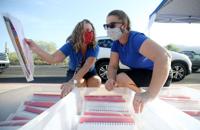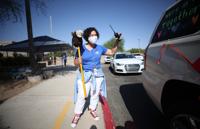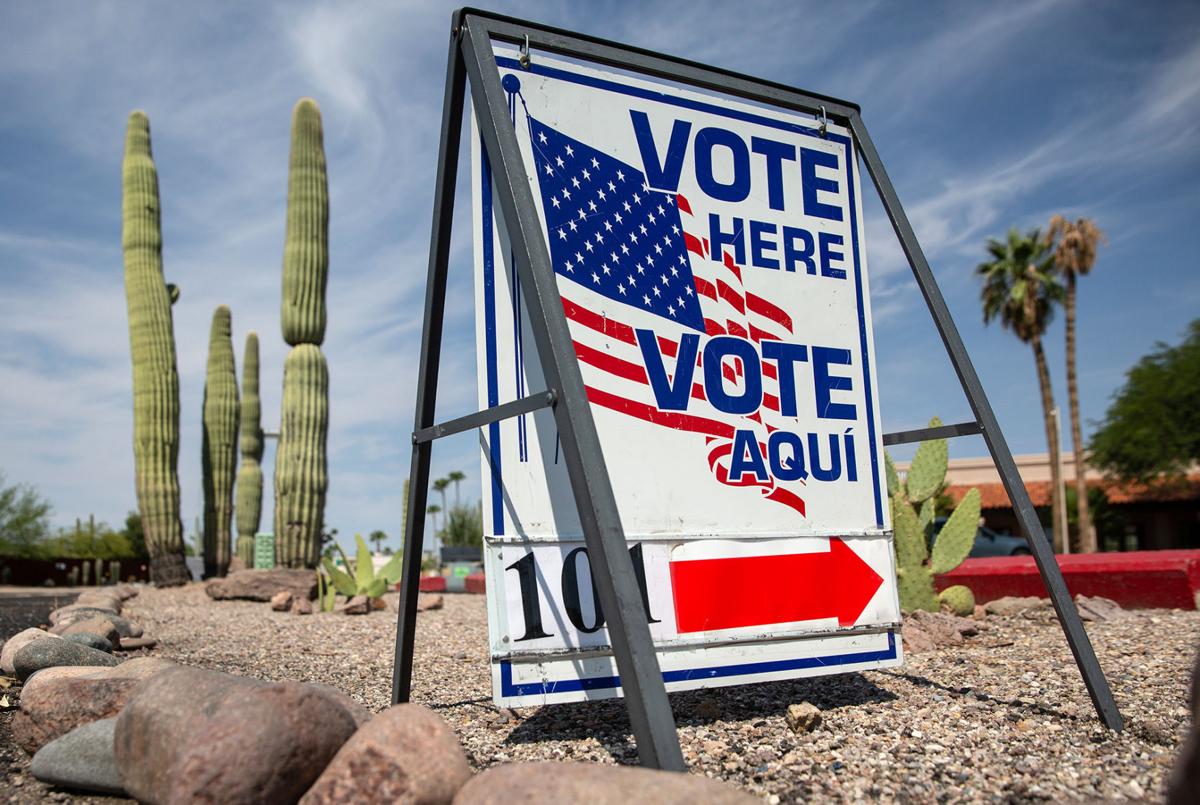PHOENIX — Arizona voters will get to decide after all in the November election whether to increase taxes on the state’s most wealthy to help fund K-12 education.
The Arizona Supreme Court ruled Wednesday that the 100-word description on petitions for the initiative known as Invest in Education “did not create a significant danger of confusion or unfairness.”
The unanimous decision reverses the previous ruling by Maricopa County Superior Court Judge Christopher Coury, and puts the initiative back on the Nov. 3 ballot.
Coury had said backers of the measure “circulated an opaque Trojan horse of a 100-word description, concealing principal provisions of the initiative.”
The high court justices also found that various methods of providing bonuses and incentives to paid petition circulators did not run afoul of state laws, which prohibit paying people on a per-signature basis.
Backers said they submitted more than 435,600 signatures; 237,645 valid signatures are needed to qualify for the ballot.
Wednesday’s ruling is most immediately a setback for the Arizona Chamber of Commerce and Industry, which financed a successful legal bid to keep a nearly identical measure from going to voters two years ago.
That means the business group and its allies now will be forced to make their arguments to voters that a tax increase — even one that affects only the top 4% of wage earners — is bad public policy.
But the measure’s proponents contend the current tax structure, including income, sales and property taxes, benefits the richest Arizonans, and that they pay proportionately less of their income to support government and public education than those at the bottom.
Arizona has a tiered income tax structure.
Individuals pay 2.59% on the first $26,500 of taxable income, 3.34% on everything between that and $53,000, 4.17% on income of $53,001 through $159,000, and 4.5% on everything over that.
Proposition 210, the Invest in Education initiative, would add a 3.5% surcharge on all incomes above $250,000 for individuals and $500,000 for couples.
So, a single person with taxable income of $350,000 a year would pay 8% — the 4.5% rate and the 3.5% surcharge — only on $100,000; taxes for everything below that $250,000 cutoff would remain the same.
Anyone whose income did not reach the threshold would be unaffected.
Proponents say that could raise $940 million a year. Legislative budget staffers put the anticipated take at $827 million for the first year.
Of whatever is collected, 50% would be earmarked for hiring and raises for teachers and classroom support personnel, with 25% for other support personnel and 10% for a program to attract and retain new teachers.
Another 12% would be for career and workforce training programs, with the balance set aside for the Arizona Teachers Academy, which provides free college tuition to those who agree to go into teaching.
Jaime Molera, who chairs the chamber-financed opposition group, called Wednesday’s ruling a disappointment, saying he still believes that proponents “deceived voters with a flawed and misleading 100-word petition summary.”
But he said the ultimate appeal will be in the “court of public opinion.”
“Damaging” impact
Molera is focusing on the fact that, for top wage earners, the tax rate would go from 4.5% to 8%, a 77.7% increase.
He contends that will create a “damaging” increase to small businesses. That is based on the argument that some businesses are set up not as regular corporations but in other forms, where the company pays no income tax and the earnings pass through to the owners who report it on their personal tax forms.
But David Lujan, who helped craft the initiative, said that is leaving out one crucial component.
He said owners do not pay taxes on the gross proceeds of their businesses but only on the net profits, after paying employees, rent and other operating costs.
And Lujan, director of the Arizona Center for Economic Progress, said Arizonans earning more than $250,000 a year as individuals or $500,000 as couples should contribute more to funding K-12 education, regardless of the source of their income.
Amber Gould, who chairs the Invest in Education campaign, called the ruling “an important victory because it gives millions of Arizona voters the opportunity to put more resources into our schools.”
She said that focusing the burden on the most wealthy ensures it will not affect working and middle-class families who have been hit by the pandemic.
One core issue of the campaign will be whether the state is providing enough money to properly finance the K-12 system.
Molera, for his part, said the state was able to implement a 20% pay raise over four years for public school teachers, all without having to increase the tax burden.
That still leaves the debate over whether Arizona is keeping pace.
Legislative budget staffers say the state is now providing $5,762 per student compared with $4,163 in 2001. But the same analysis shows that, after adjustments for inflation, state aid now is 4.5% less than it was in 2001.
Republican Gov. Doug Ducey has staked out a position against the tax increase on the wealthiest.
“That’s a whopping amount, especially considering that our economy is recovering from recession and high unemployment,” he wrote in a statement against the measure.
Arizona Daily Star readers generously share their sunset photos.
Photos: Back-to-school in Tucson during the pandemic
"Mustang Stampede"
Updated
Maddy Jacobs, 7, middle, reaches for her remote learning tool kit from her teacher, Kris Green, as her friend, Carly Kupinski, 6, watches during a "Mustang Stampede" at Manzanita Elementary School for the first day of school on August 17, 2020.
First Day of School, John B. Wright Elementary
Updated
Augusta Iranzi, center, attends his teachers online class while monitors Jasmine Phillip, left, and Nadifo Yusuf, watch students inside a classroom at John B. Wright Elementary School, 4311 E. Linden St., in Tucson, Ariz. on August 17, 2020. About 10 students came to school for online instruction under the guidance of classroom monitors.
"Mustang Stampede"
Updated
Lily Baser, 8, identifies herself for easy remote learning tool kit pickup during a "Mustang Stampede" at Manzanita Elementary School for the first day of school on August 17, 2020.
"Mustang Stampede"
Updated
Krista Westmoreland, left, a third grade teacher, shows the remote learning tool kit of a student to Anna Ames, music teacher, during the "Mustang Stampede" at Manzanita Elementary School for the first day of school on August 17, 2020.
"Mustang Stampede"
Updated
Maya Brown, 9, rides in style for her remote learning tool kit pickup during a "Mustang Stampede" at Manzanita Elementary School for the first day of school on August 17, 2020.
"Mustang Stampede"
Updated
Multiage teachers Kris Green left, and April Pollow greet and cheer on their students during a "Mustang Stampede" at Manzanita Elementary School for the first day of school on August 17, 2020.
"Mustang Stampede"
Updated
Maddy Jacobs, 7, left, waves to her teacher as she stands in the sunroof with her friend, Carly Kupinski, 6, during a "Mustang Stampede" to pickup their remote learning tool kit at Manzanita Elementary School for the first day of school on August 17, 2020.
"Mustang Stampede"
Updated
For the first day of school teachers at Manzanita Elementary School greeted their students during a "Mustang Stampede" and handed out remote learning tool kits on August 17, 2020.
"Mustang Stampede"
Updated
Kim Boling, principal at Manzanita Elementary School, greets her students and parents with a mustang during the "Mustang Stampede" for the first day of school on August 17, 2020.
First Day of School, John B. Wright Elementary
Updated
Yarani Martinez gives a monitor a thumbs up to inform the monitor that his online class is working after classes began at John B. Wright Elementary School, 4311 E. Linden St., in Tucson, Ariz. on August 17, 2020. About 10 students came to school for online instruction under the guidance of classroom monitors.
First Day of School, John B. Wright Elementary
Updated
Alice Flores, right, watches as her grandson Jesus Silva is escorted to the cafeteria before classes began at John B. Wright Elementary School, 4311 E. Linden St., in Tucson, Ariz. on August 17, 2020. About 10 students came to school for online instruction under the guidance of classroom monitors.
First Day of School, John B. Wright Elementary
Updated
Augusta Iranzi follows the directions on the floor while being escorted to a classroom at John B. Wright Elementary School, 4311 E. Linden St., in Tucson, Ariz. on August 17, 2020. About 10 students came to school for online instruction under the guidance of classroom monitors.





